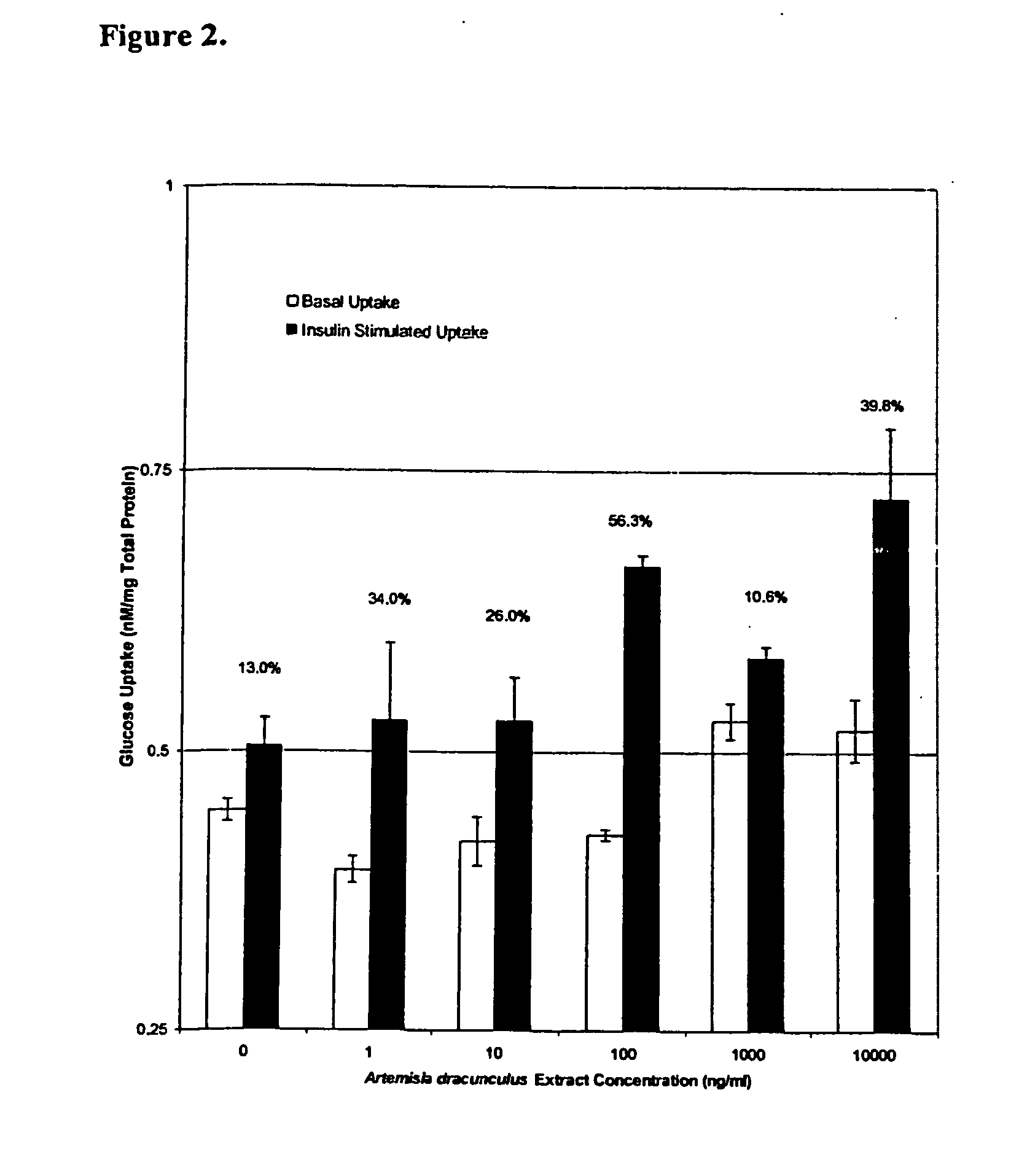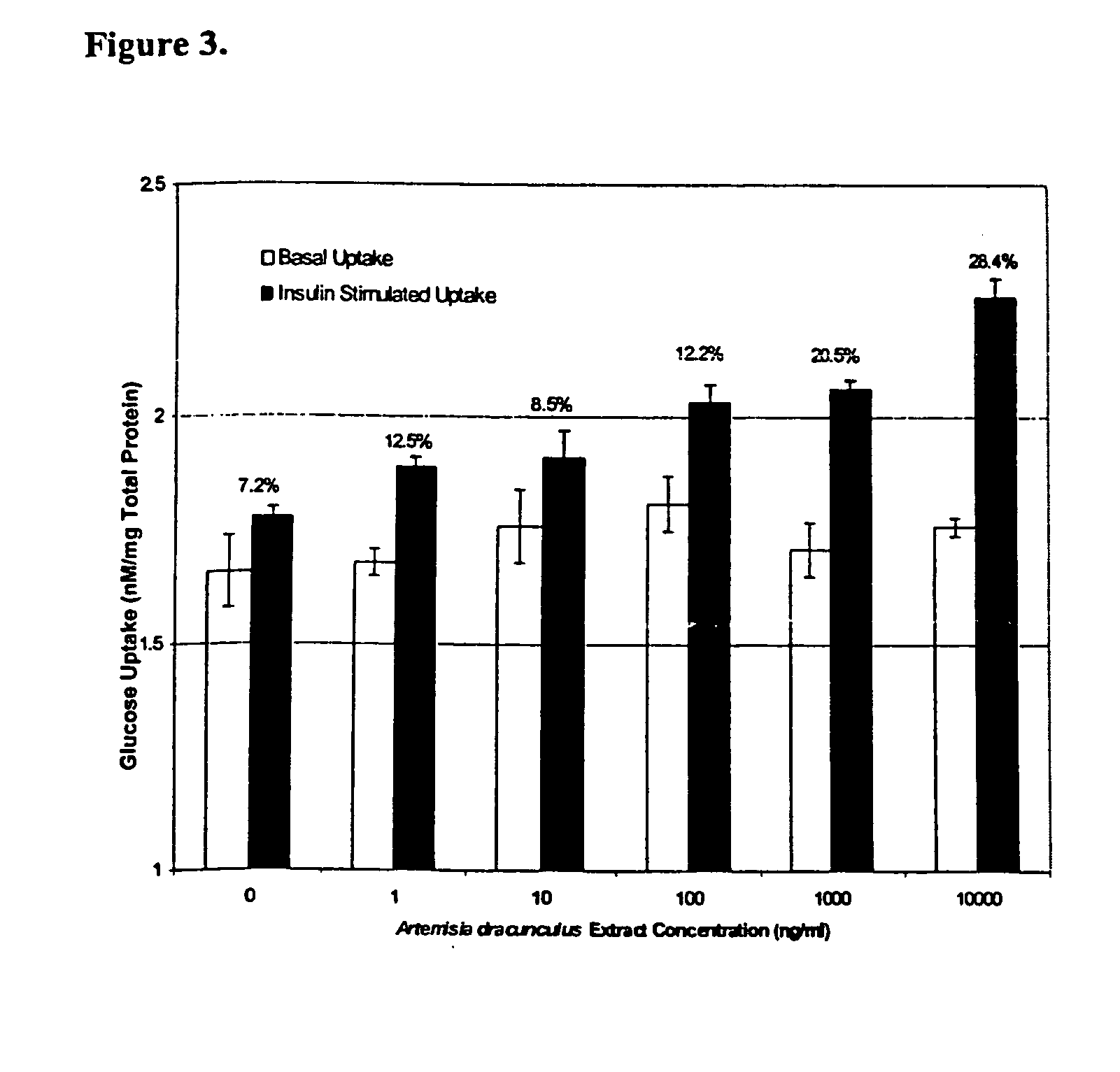Methods for treating disorders using plant extracts
a technology of plant extracts and disorders, applied in the field of materials and methods for treating disorders using plants, can solve the problems of secondary health problems that require additional medical treatment, inability to control blood glucose levels, and insufficient indicators, so as to improve the activity of insulin receptor agonists, and improve the effect of hyperglycemia
- Summary
- Abstract
- Description
- Claims
- Application Information
AI Technical Summary
Benefits of technology
Problems solved by technology
Method used
Image
Examples
example 1
Extract Preparation
Artemisia dracunculus seeds (Richters Seeds) were germinated in a 0.9 cm deep well inside Grodan rock wool cubes (3.4 cm width×3.4 cm depth×3.7 cm height). One week later the seedlings were placed into a hydroponic system with a nutrient solution (120 g Hydro-Sol [Scotts-Sierra Horticultural Products Comp., Marysville, Ohio, USA] supplemented with 5 g NH4NO3 and 90 g Ca(NO3)2 in 60 liters of water). Aeration was provided by bubbling compressed air through the hydroponic nutrient solution at a flow rate of about 100 ml per minute for deep hydroponics (i.e., continuous immersion in water deeper than 4 cm). Alternatively, the seedlings were placed into a shallow gutter hydroponic system with a continuous flow of nutrient solution. The plants were elicited with 0.1% chitosan in the hydroponic solution 24 hours prior to harvest. The use of chitosan for elicitation of the plants provided greater hypoglycemic (i.e., blood glucose lowering) activity than untreated plant...
example 2
Efficacy of Alcoholic Extract of Artemisia dracunculus
The efficacy of the Artemisia dracunculus extract was evaluated in Streptozotocin (STZ)-treated mice. STZ induces diabetes by destroying most, if not all, of the beta cells of the pancreas, leaving the animals with little or no insulin production and severe hyperglycemia [Hisashi, et al., European Journal of Pharmacology, 87:237-243 (1983)]. This is a stringent assay for anti-diabetic efficacy, in which many of the currently prescribed drugs do not show significant activity. Mice were treated with STZ as described by Hisashi et al., European Journal of Pharmacology, 87:237-243 (1983). A 500 mg / kg dose of Artemisia dracunculus extract was administered daily by oral gavage to STZ-treated mice for a period of 7 days. Additionally, a dose of insulin (1 IU / kg) was administered subcutaneously to STZ-treated mice, while 20 ml / kg of vehicle only (0.9% NaCl or 2% Tween 80 in distilled water) was administered to STZ-treated mice, as a co...
example 3
Hypoglycemic Activity of Alcoholic Extract on Non-Diabetic Mice
The possible hypoglycemic activity of Artemisia dracunculus extracts was investigated in non-diabetic mice. The mice were exposed to Artemisia dracunculus extracts prepared as described in Example 1, which were administered orally to the mice in the form of a coating on their food. To obtain reliable data, control mice were provided with vehicle-coated food. The vehicle was 0.9% NaCl or 2% Tween 80 in distilled water. The feeding regimen was continued for seven days, and insulin and blood glucose levels were then determined using a technique well known in the art. (ELISA Insulin Assay kit (SPI bio, France); Glucose-HA Assay kit (Wako, Japan)). Mice fed vehicle (10 ml / kg) served as the control. Artemisia dracunculus extracts, at a dosage level of 500 mg / kg, caused statistically insignificant reductions in the blood glucose concentrations of non-diabetic animals; the changes in insulin concentrations of the extract-fed m...
PUM
 Login to View More
Login to View More Abstract
Description
Claims
Application Information
 Login to View More
Login to View More - R&D
- Intellectual Property
- Life Sciences
- Materials
- Tech Scout
- Unparalleled Data Quality
- Higher Quality Content
- 60% Fewer Hallucinations
Browse by: Latest US Patents, China's latest patents, Technical Efficacy Thesaurus, Application Domain, Technology Topic, Popular Technical Reports.
© 2025 PatSnap. All rights reserved.Legal|Privacy policy|Modern Slavery Act Transparency Statement|Sitemap|About US| Contact US: help@patsnap.com



